Pre-war
Commercial Studebaker Vehicles
 All the early Studebaker commercial vehicles 1914 through 1917, except the Flanders Delivery (1912) most likely had the "Studebaker" script badge on the front of their radiators. Some 1916 & 1917 production may have used the Wheel badge shown next. All the early Studebaker commercial vehicles 1914 through 1917, except the Flanders Delivery (1912) most likely had the "Studebaker" script badge on the front of their radiators. Some 1916 & 1917 production may have used the Wheel badge shown next.
The wheel badge at the (left) was in use for cars and commercial vehicles from 1916 to 1919 and again for 1926 and 1927. It was placed near the top of the radiator shell. This one was used for exports because of the "MADE IN U.S.A." label seen at the bottom. Most domestic units used a similar badge without that bottom label shown at the left. The badge at the (right) was slightly smaller then the first one and was used mid 1928 through 1929.
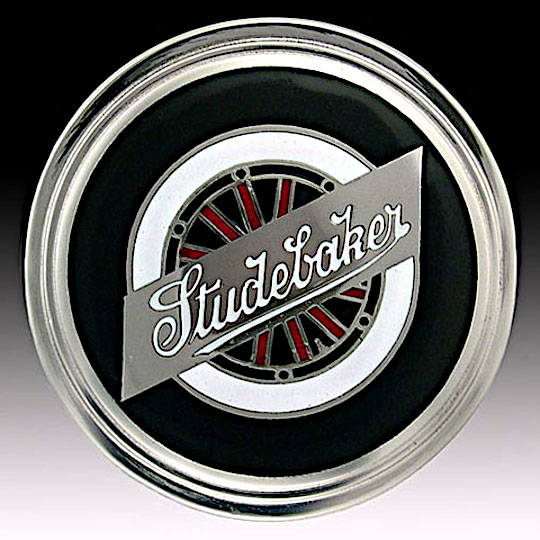
The badge at the (left) was used from 1928 to 1931. It is smaller yet then the second badge shown above. It is unknown when in 1928 this badge may have been created, but clearly both the badge (right) above and this badge were in use at the same time during 1928 and 1929. The use of the rectangular badge shown below starts in 1930, but we don't know for sure if all commercial vehicles used it. If we had to guess, the badge at the (left) was most likely used on the lighter vehicles and the one below on the larger trucks, at least for 1930. Some sort of wheel badge was used on cars and some commercial funeral cars and ambulances through 1935.
These two badges replaced the former "Studebaker Wheel" front radiator shell badge used prior to the 1930 introduction of S-series trucks. The lower badge was used on export trucks as it has the "MADE IN U.S.A." label at the top. Early in 1930 these badges were only applied to the larger trucks. Later all trucks would have these badge through 1931.
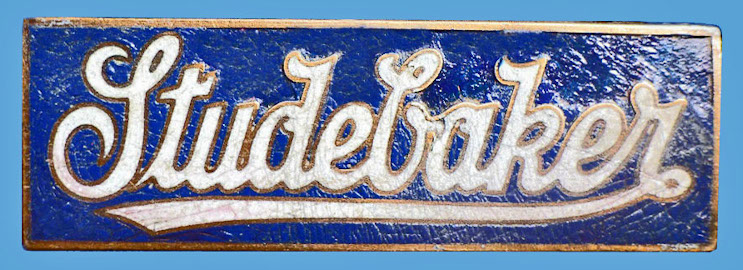 This badge was the same length, but roughly 1/2 as high as the former badges above. We are sure there was an equivalent "MADE IN U.S.A." labeled badge for export, but we could not find a photo of it. Studebaker began using the narrow badge some time in 1932 and most likely it was used until the end of the S-series truck production in March of 1934. This badge was the same length, but roughly 1/2 as high as the former badges above. We are sure there was an equivalent "MADE IN U.S.A." labeled badge for export, but we could not find a photo of it. Studebaker began using the narrow badge some time in 1932 and most likely it was used until the end of the S-series truck production in March of 1934.
This badge is first seen on the T&W-series trucks, placed on the top of the new grille. The "V" shaped bottom was most likely done to match the outline of the top of that grille. This badge would have been used on export trucks as it has the "MADE IN U.S.A" label on the top.
 This badge began to appear on the sides of the truck hoods from maybe late 1930, but for sure in 1931. It's use seems to coincide with the introduction of the S-series trucks, but lasted until the introduction of the 1T&W-series trucks of 1935 which would used the winged badges. (circa 1931 to 1935) This badge began to appear on the sides of the truck hoods from maybe late 1930, but for sure in 1931. It's use seems to coincide with the introduction of the S-series trucks, but lasted until the introduction of the 1T&W-series trucks of 1935 which would used the winged badges. (circa 1931 to 1935)
 This side hood badge was used on the J-series trucks starting in January of 1937. The 2T, 2W, and 2M series production overlapped J-series by four months, so some trucks made in 1937 used the badges covered above and below. The J-series trucks did not have a grille badge.(This is a reproduction created with a graphic tool and is not exact.) This side hood badge was used on the J-series trucks starting in January of 1937. The 2T, 2W, and 2M series production overlapped J-series by four months, so some trucks made in 1937 used the badges covered above and below. The J-series trucks did not have a grille badge.(This is a reproduction created with a graphic tool and is not exact.)
 This side hood badge was used on the K-series trucks from 1938 to 1942. Actually only 597 J-series trucks are built after the release of the M-series in 1941. The K-series also used a large "S" badge on the lower part of the front grille. (This is a reproduction created with a graphic tool and is not exact.) This side hood badge was used on the K-series trucks from 1938 to 1942. Actually only 597 J-series trucks are built after the release of the M-series in 1941. The K-series also used a large "S" badge on the lower part of the front grille. (This is a reproduction created with a graphic tool and is not exact.)
With the introduction of the 1T&W-series the trucks were given names, the 1 1/2 ton was named "ACE", the 2 ton "BOSS", the 2 1/2 ton "Mogal", and the 3 ton "Chief" (later BIG CHIEF). The named side hood badge, example shown at the bottom were used on 1T&1W-series. The winged badges would be used on the front of the grille and on either the side hood for "Standard" or the the doors for "Cab Forward" with the release of the 2T, 2W & 2M-series for 1936. Their use would end with the release of the J-series trucks. No truck names would be used until after the war.
Source: The information and photo above except where noted were extracted from a website "American Auto Emblems" by Mike Shears and his son Murray John Shears. Click the link to open it in another window, we are sure you will enjoy.
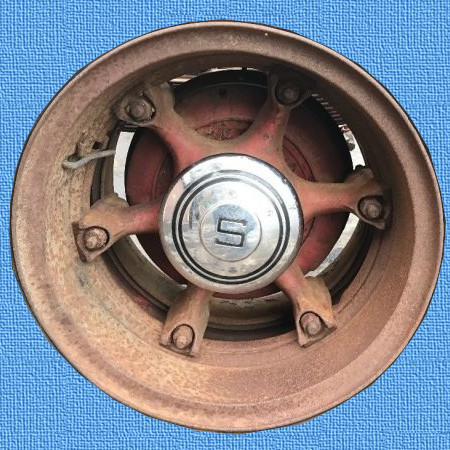 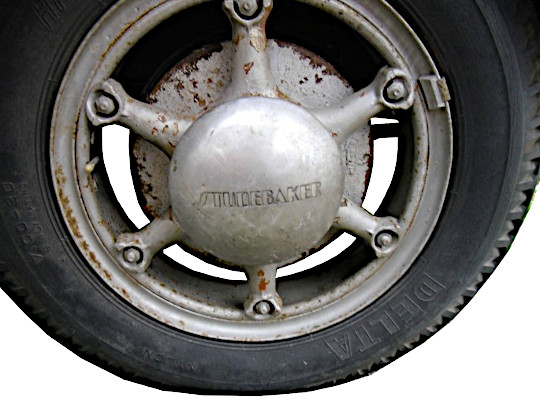 The 2T, 2W & 2M series trucks would have for the first time these larger hubcaps (left). The J-series and K-series trucks would use the even larger and rounder hubcaps shown at the (right). The smaller trucks (pickups) like the Coupe Express used what ever hubcaps the cars from the same year used. Other lighter trucks like the Fast-Transport used an even larger , but flatter hubcap not shown. The 2T, 2W & 2M series trucks would have for the first time these larger hubcaps (left). The J-series and K-series trucks would use the even larger and rounder hubcaps shown at the (right). The smaller trucks (pickups) like the Coupe Express used what ever hubcaps the cars from the same year used. Other lighter trucks like the Fast-Transport used an even larger , but flatter hubcap not shown.
The early commercial vehicles, through about 1931 used the same or similar radiator caps as were seen on 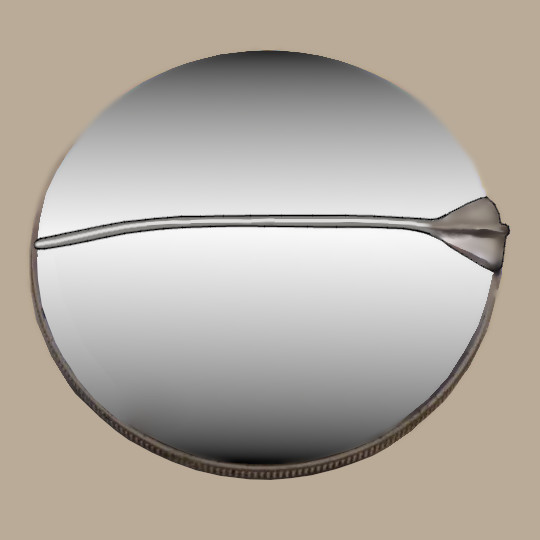 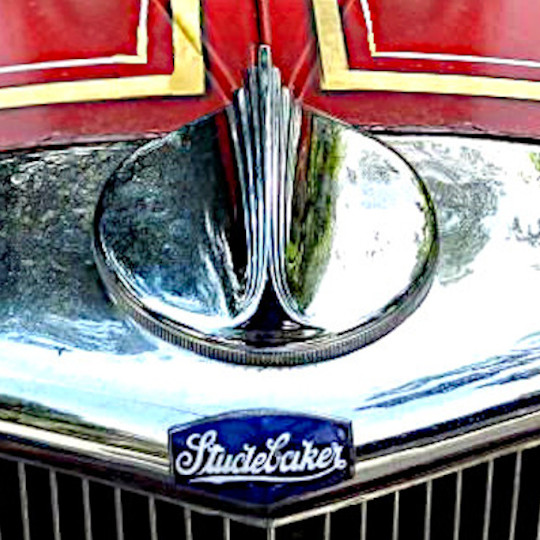 the cars. From 1932 & 1933 most trucks used a winged cap (#632465), we think it may have been the one shown at the (left). For 1934 & 1935 a slightly more ornate cap (#634769) was used, we think it most likely is the one shown at the (right). the cars. From 1932 & 1933 most trucks used a winged cap (#632465), we think it may have been the one shown at the (left). For 1934 & 1935 a slightly more ornate cap (#634769) was used, we think it most likely is the one shown at the (right).
(This is a reproduction created with a graphic tool and is not exact.)
Starting in 1936 with the 2T, 2W, 2M truck and then also used on the J-series and K-series trucks was the "Flying Wheel" shown at the (left). Again like the hubcaps the Coupe Express for each year and maybe a few other commercial vehicles would use the car radiator mascots from that year.
Side Bar: With regards to all the tells listed and shown above, very few of the commercial vehicles from before the war have survived. Parts for these restorations, when undertaken were very hard to find. Most were restored by folks who are no longer with us and their restorations are in museums or very private collections. Many restorations were not completely accurate because the parts required to do so simply did not exist or could not be found. The warning here is you may very well be looking at 2T truck with a K-series grille, if you are even lucky enough to be looking at one at all.
Prelude: In the early charts below, there is mostly no production numbers, because one they for
the most part are not available and two, production numbers are
mainly interesting to determine how rare a particular vehicle might
be. As these were commercial vehicles, they most likely were driven
into the ground, constructed mostly of wood (prior to 1937) and very few if any have
survived. Thus any unit that survives today is extremely rare
regardless of how many might have been produced.
The
history of pre-war production and sales of Studebaker's commercial vehicles
seems to work best if viewed from two time frames. The
first period actually started, before the first cars to carry a
Studebaker badge (1913) were produced, with the 1912 Flanders
Delivery. This period ends suddenly after 1917, when Studebaker
abandoned the commercial market to focus on it's car line. The second period starts in 1926 and ends, with the start of WW II, in the shorted 1942 production year.
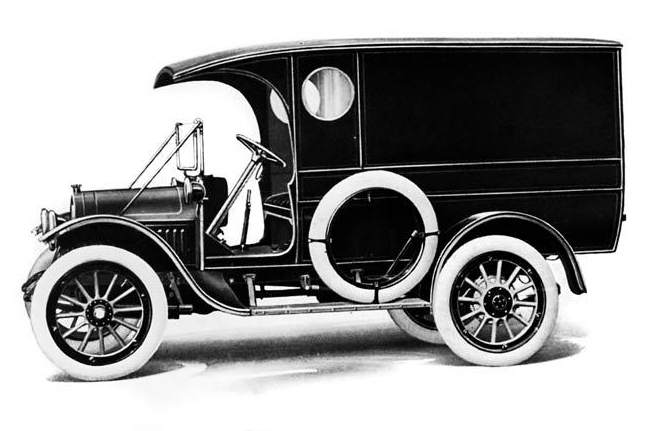 Factory
production for this period starts with the Flanders 20 Delivery. Because of the Flanders fragile drive train it most likely was not to
successful and no counter part would be offered in Studebaker's 1913
model line-up. Factory
production for this period starts with the Flanders 20 Delivery. Because of the Flanders fragile drive train it most likely was not to
successful and no counter part would be offered in Studebaker's 1913
model line-up.
Photo at the left 1914 Panel Delivery.
In 1914
Studebaker would release two 1,500 pound commercial vehicles, an
enclosed panel or open express delivery, built on the identical SC
passenger car chassis with some reinforcement of the frame and
suspension and larger tires. These two vehicles continued into 1915
with minor improvements and a slightly lower price. In March 1915 a
14-passenger Jitney Bus was added. In 1916
Studebaker would release two new chassis, a 1,000 pound 112 inch
wheel base unit and a 2,000 pound 125 inch wheel base unit. The
first chassis would be offered in Panel Delivery (closed), Express
Delivery (open) and a combination Express and Passenger model with
folding seats in the back. The second chassis would be offered in
Open Express, a Stake Truck and a 16-passenger Bus. Our source does
not mention any modification or price changes for 1917, so it appears
these models continued unchanged for that year, after which commercial vehicle production stopped until
1926.
In
addition to the models listed below (standard production models) a
number of specialized vehicles were built on Studebaker chassis,
which included fire engines built by Northern Fire Apparatus Company
of Minneapolis Minnesota, hearses and ambulances built by
McCabe-Powers Company of St. Louis, Missouri and special funeral cars
made by Knightstown Buggy Company, Knightstown, Indiana. Some if not
all were sold through Studebaker dealers. All of
these vehicles were produced by Studebaker in Detroit, prior to the
move of Studebaker production to South Bend.
|
Year |
Model |
Model Description |
Type |
Price |
|
1912 |
20 |
Flanders 20 |
Delivery |
$800.00 |
|
1914 |
3 |
Express Wagon |
Delivery |
$1,150.00 |
|
1914 |
3 |
Delivery Wagon |
Delivery |
$1,150.00 |
|
1915 |
5 |
Express Wagon |
Delivery |
$1,085.00 |
|
1915 |
5 |
Delivery Wagon |
Delivery |
$1,085.00 |
|
1915 |
5 |
14-pass Jitney Bus |
Bus |
$2,235.00 |
|
1916/1917 |
7 |
½ Ton Express
Delivery |
Delivery |
$825.00 |
|
1916/1917 |
7 |
½ Ton Panel
Delivery |
Delivery |
$875.00 |
|
1916/1917 |
7 |
½ Ton Combo
Express/Pass |
Delivery |
$875.00 |
|
1916/1917 |
7 |
1 Ton Open Express |
Truck |
$1,200.00 |
|
1916/1917 |
7 |
1 Ton Stake |
Truck |
$1,250.00 |
|
1916/1917 |
7 |
16-pass Bus |
Truck |
$1,400.00 |
Source: Most of the information in the
above section comes from “Studebaker the Complete Story” by
William A. Cannon and Fred K. Fox
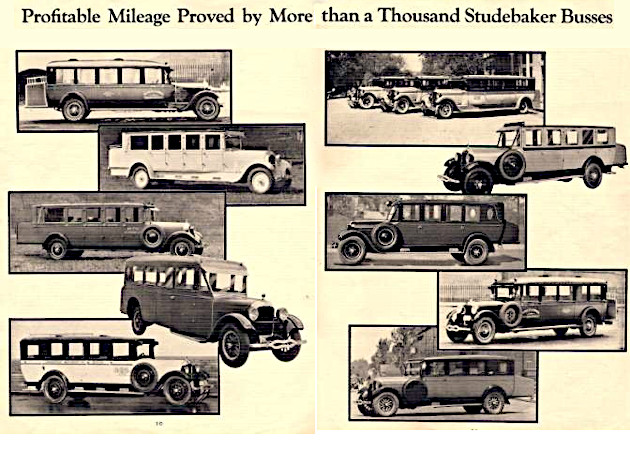 The photo to the right is a period post card The photo to the right is a period post cardStudebaker is really into bus sales circa 1926
The
second period started in 1926 with a line of commercial busses and
continued until 1942. Little is known, about the portion of the
second period, from 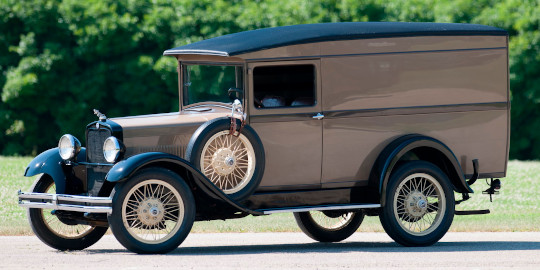 1926 to 1930. With the exception of one 1928
Erskine Panel Delivery we did not find any evidence of other
survivors. The period started in 1926 with the release of a series
of intercity buses powered by the Big Six engine. In June of 1927
the Arlington Funeral car and the Bellevue ambulances were released
and we know a little about their selection and price by looking at a
period ad which highlighted information about the National Funeral
Directors convention of 1929 held in Cincinnati Ohio. 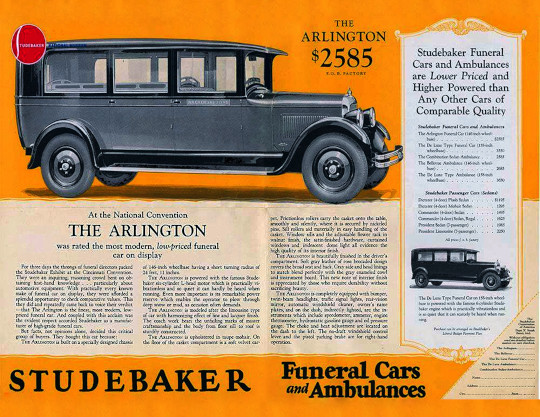 The ad we
found has the “Studebaker National Museum's logo and listed
Studebaker's offerings and prices for 1929. Co-incidentally the
bodies for these cars were manufactured by Superior Body Company of
Lima, Ohio and marketed through Studebaker dealers. In addition we
know from numerous period photographs that a significant number of
specialized vehicles hearses, ambulances, buses and delivery vehicles
were sold, all using standard Studebaker six or eight car engines and
specialized frames and suspension. Note, that the Westminster
Funeral cars and Samaritan Ambulances were powered by either the
Commander eight or the President eight, while the Arlington Funeral
car and Bellevue ambulances used either the Dictator six or the
Commander six. The ad from 1929 (left) listed DeLuxe Funeral and
Ambulances on a 158 inch wheelbase and a Combination Sedan/Ambulance
which were not listed in “Studebaker the Complete Story”, thus we
don't know if any of these models were actually produced as
automotive advertising is notorious for listing things which actually
never happened. From Skip Lackie's truck history, we know that it
was not until the 1929 with the release of the GN truck series that a
full line of commercial vehicles powered by the 68 horsepower
Dictator six engine was made available. This series ranged from
Funeral/Ambulance to 2 Ton truck.
|
Year |
Model |
Model Description |
Type |
Price |
|
1926/1927 |
N |
12 – 15 Passenger
Bus |
Bus |
? |
|
1926/1927 |
A |
18 – 20 Passenger
Bus |
Bus |
? |
|
1926/1927 |
D |
18 – 25 Passenger
Bus |
Bus |
? |
|
19271 |
EY |
Arlington Funeral
Car (146 wb) |
Car |
$2,565.00 |
|
19271 |
EY |
DeLuxe Type
Funeral Car (158 wb) |
Car |
$3,550.00 |
|
19271 |
EY |
Combination
Sedan/Ambulance |
Car |
$2,585.00 |
|
19271 |
EY |
Bellevue Ambulance
(146 wb) |
Car |
$2,685.00 |
|
19271 |
EY |
DeLuxe Ambulance
(158 wb) |
Car |
$3,650.00 |
|
1928 |
GD |
Arlington Funeral
Car (146 wb) |
Car |
? |
|
1928 |
GD |
Bellevue Ambulance
(146 wb) |
Car |
? |
|
1928 |
GD |
One Ton Commercial
(146 wb) |
Truck |
? |
|
1928 |
51B |
Erskine Panel
Delivery |
Delivery |
1928? |
|
1929 |
52B |
Erskine Panel
Delivery |
Delivery |
? |
|
1928 |
75 |
Junior Bus |
Bus |
? |
|
1928 |
76 |
Chassis |
Chassis |
? |
|
1929/1930 |
FJ |
Westminster Funeral
Car |
Car |
? |
|
1929/1930 |
FJ |
Samaritan Ambulance |
Car |
? |
|
1929/1930 |
FE |
Westminster Funeral
Car |
Car |
? |
|
1929/1930 |
FE |
Samaritan Ambulance |
Car |
? |
|
1929/1930 |
FL |
Funeral Car |
Car |
? |
|
1929/1930 |
FL |
Ambulance |
Car |
? |
|
1929/1930 |
GN |
Funeral/Ambulance
Car |
Truck |
? |
|
1929/1930 |
GN-20 |
¾ ton Delivery |
Truck |
? |
|
1929/1930 |
GN-30 |
1 ton Commercial |
Truck |
? |
|
1929/1930 |
GN-40 |
2 ton Commercial |
Truck |
? |
|
1929/1930 |
77 |
Junior Bus |
Bus |
? |
|
1929/1930 |
88 |
Special Bus |
Bus |
? |
|
1929/1930 |
99 |
Heavy Duty Bus |
Bus |
? |
|
1929/1930 |
111 |
Heavy Duty Bus |
Bus |
? |
|
1This
information was extracted from a period Studebaker advertisement. |
Source: Most of the information in the
above section comes from “Studebaker the Complete Story” by
William A. Cannon and Fred K. Fox, Skip Lackie “Studebaker Truck
History” and Studebaker National Museum period advertisement.
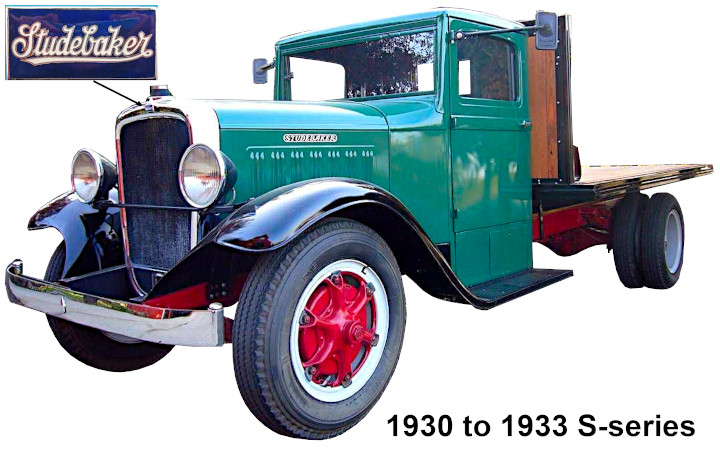
In the
fall of 1930 Studebaker would release it's first real truck line the
S-series trucks, for the 1931 model year. This series starts with
the Dictator passenger car based S-1 ½ ton and included larger
trucks from 1 ½ ton to 3 ton models. The S-series seems to have
started in 1930 with the release of the 1 ½ ton model “S” and
continued through the 1933 model year, including the S-100, S-101,
S-102 Funeral/Ambulances, the S-1 ½-ton delivery, the S-2 1-½ ton
truck, S-111 & S-116 delivery, S-4 1 3/4-ton truck, S-6 2-ton
truck, and the S-8 3-ton truck. The S-4
through S-8 production overlaps the later 1934 “T” truck series. A total of 7,538 S-series trucks were built between August 1930 and
March 1934. The majority were built in South Bend, but a small
number were built in Walkersville, Ontario CA in 1931 and 1932.
Side
Bar:
I have
been unable to find prices for any of the S Series Studebaker trucks,
but I did find a period advertisement from 1931 which listed prices
for 1 ½-ton chassis, 130 inch wheel base at $695.00 and 160 inch
wheel base at $765.00. It appears these were standard as single rear
wheels as the ad stated “Duel rear wheels and auxiliary springs
optional at extra cost.” That same ad listed prices for the 2-ton
chassis, 136 inch wheel base at $945.00, 148 inch wheel base at
$895.00 and 160 inch wheel base at $945.00. The 2-ton chassis had
duel rear wheels standard, but “auxiliary springs optional at extra
cost.” The ad further states that cabs and standard bodies,
including panel, screen, express, stake, canopy, grain, cattle and
dumps were available (at extra cost but not specified.) Bumpers were
also an extra cost item.
In
addition the ad did price a complete ½ ton Panel or Screen at
$895.001.
|
Year |
Model |
Model Description |
Type |
Price |
|
1931 |
S-100 |
Funeral/Ambulance
Car 154wb |
Car |
? |
|
1932 |
S-101 |
Funeral/Ambulance
Car 152wb |
Car |
? |
|
1933 |
S-102 |
Funeral/Ambulance
Car 152wb |
Car |
? |
|
1930/1931 |
S |
1 ½ / 2-ton Truck
130/136/148/160wb |
Truck |
? |
|
1931 |
S-1 |
½-ton Delivery
(Panel or Screen) 114wb |
Delivery |
$895.001 |
|
1932/1934 |
S-2 |
1 ½-ton Truck
130/141/165wb |
Truck |
? |
|
1932 |
S-111 |
Delivery ?wb |
Delivery |
? |
|
1932 |
S-116 |
Delivery ?wb |
Delivery |
? |
|
1932/1934 |
S-4 |
1 3/4-ton Truck
130/141/165wb |
Truck |
? |
|
1932/1934 |
S-6 |
2-Ton Truck
130/141/165wb |
Truck |
? |
|
1932/1934 |
S-8 |
3-ton Truck
130/141/165wb |
Truck |
? |
|
Model
S-2 includes S-21 and S-31
Model
S-6 includes S41, S-51 and S-61
Model
S-8 includes S-120, S-30, S-140 and S-150 |
Source: Most of the information in the
above section comes from “Studebaker the Complete Story” by
William A. Cannon and Fred K. Fox, Skip Lackie “Studebaker Truck
History.”
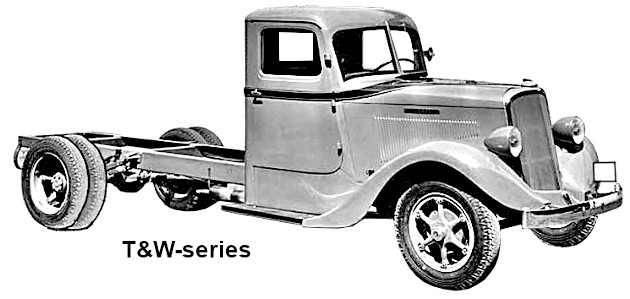 With the
introduction of the T & W Series in 1934 there is a somewhat
greater commitment to stylizing the truck line and expanding the load
capacity. The first T&W series trucks 1930/1931 seems to have the vertical side hood louvers, slightly slanted forward at the bottom. Before this truck, hood side louvers had been vertical, but straight.
The trucks had new flowing front fenders with skirts, a
new hood and a new slanted grille which covered the radiator for the
first time. The 1934/1935 grille starts out fairly simple with a “V”
shape, with a series of vertical bars on either side. In 1936 a
similar grille would be more rounded and sport three sets of single
horizontal bars. The 1936 trucks could be order with either the new
more streamlined DeLuxe cab with a sloping two-piece windshield and
contrasting color band swiping across the hood to the doors, or use
the 1932 to 1934 square cab, still available at a lower cost. This
series includes the T-2 through T-8 and W-8. Beginning in March of
1934 T-series trucks would also be assembled in Walkersville Canada. 3,146 T-series were built in 1934 and another 370 were assembled in
South Bend in the first few month of 1935. No trucks were built in
Walkersville after December of 1934. The T trucks are Studebaker
powered, where the W Series is powered by Waukesha engines (I expect
that's the merit for the “W”).
The T &
W series is succeeded by a limited 1T & 1W series in March of
1935. The poor selling T4 & T8 trucks are eliminated, but a new
1W7 is added. During this time frame, these models were given names. The 1T2 was called the Ace, the 1T6 the Boss, the 1W7 the Mogal and
the 1W8 the Chief (later the Big Chief).
The photo at the left has horizonal louvers and a side hood Studebaker badge which seems to be confined to the 1T & 1W trucks (1935). The wing badges are not yet present, but will start some time this same year.
At about the middle of the
year, those names would be added to the winged Studebaker emblems
attached to the grille and hood sides. The trucks would only bear
these names through 1936 and would not be carried on into the
J-series trucks which began in January of 1937. A total of 4,005
1T/1W-series trucks are built only in South Bend from March 1935 to
November of 1935
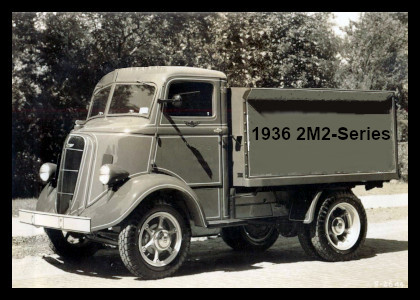 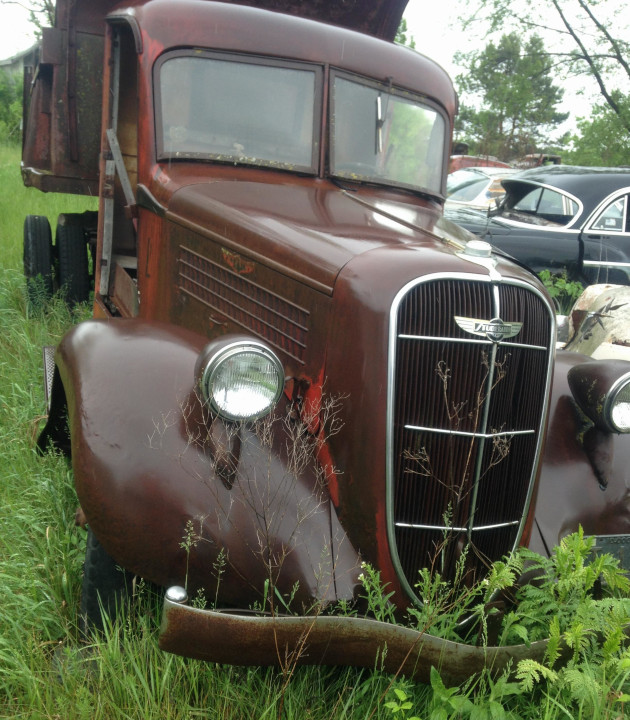 In
December of 1935 the 2T & 2W series is released. These trucks
would be referred to as the “Standard Series”, more on this
later. These trucks got a new bumper, a more rounded grille and
horizontal rather then vertical hood louvers. Only 1,981 were built
from December of 1935 to April of 1937. Now the rest of the story. In January of 1936 Studebaker would get into the Cab Over Engine
(COE) truck business with the release of their version they called
“Cab Forward” (2M-series). They would share most of the same
mechanical components as the conventional trucks, but ran on much
shorter wheel bases. This line of trucks were intended for the
metropolitan truck market where maneuvering in alleys and other tight
spots would be easier with a shortened truck with similar
payloads. Initially called “Metro”, short for metropolitan, that
name was short lived as International-Harvester had a trademark on
the name “Metro” and quickly let Studebaker know they would be
enforcing it. Studebaker did however continue the “M” letter
designation for it's Cab-Forward trucks. The M-series trucks did
fare a bit better as 2,260 2M-series trucks were built between
January of 1936 to February of 1937.
Side
Bar: Few M-series trucks have survived as the cabs frames were wood
with steel sheathing. While the later Standards series trucks would
have all steel cabs, because of low production, the M-series
Cab-Forward trucks would be built as described above until the end of their production in 1940.
|
Year |
Model |
Model Description |
Type |
Price |
|
1934 |
T-2 |
1 ½-ton Standard
Truck 130/141/165wb |
Truck |
$625.001 |
|
1934 |
T-4 |
1 ¾-ton Standard
Truck 130/141/165wb |
Truck |
$785.001 |
|
1934 |
T-6 |
2-ton Standard
Truck 141/165/183wb |
Truck |
$945.001 |
|
1934 |
T-8 |
3-ton Standard
Truck 141/165/183wb |
Truck |
$945.001 |
|
1934 |
W-8 |
Big Chief 2-ton
Truck141/165/183 wb |
Truck |
? |
|
1935 |
T-2 |
1
½-2 ton Standard Truck 130/141/165wb |
Truck |
? |
|
1935 |
T-6 |
2-3 ton Standard
Truck 141/165/183wb |
Truck |
? |
|
1935 |
W-7 |
Mogul 3-ton
141/165/183wb |
Truck |
? |
|
1935 |
W-8 |
Big Chief 3-ton
Truck141/165/183 wb |
Truck |
? |
|
1936 |
2T2 |
Standard Truck-Ace
125/133/157wb |
Truck |
$565.001 |
|
1936 |
2T2B |
Bus 157wb |
Bus |
|
|
1936 |
2M2 |
Cab Forward Truck
101/125wb |
Truck |
$595.001 |
|
1936 |
2M6 |
Metro Boss
101/125/157wb |
Truck |
? |
|
1936 |
2M6B |
Bus 167wb |
Bus |
? |
|
1936 |
2W6 |
Boss Truck,
Standard 133/157/175wb |
Truck |
? |
|
1936 |
2W7 |
Standard Truck
141/165/183wb |
Truck |
? |
|
1936 |
2W8 |
Standard Truck
141/165/183wb |
Truck |
? |
|
1These
prices have been extracted from period advertisements and are for
chassis only, not complete trucks. |
Source: Most of the information in the
above section comes from “Studebaker the Complete Story” by
William A. Cannon and Fred K. Fox, Skip Lackie “Studebaker Truck
History.”
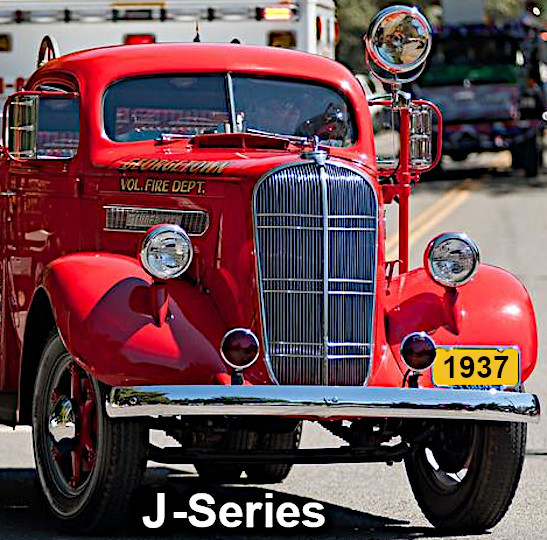 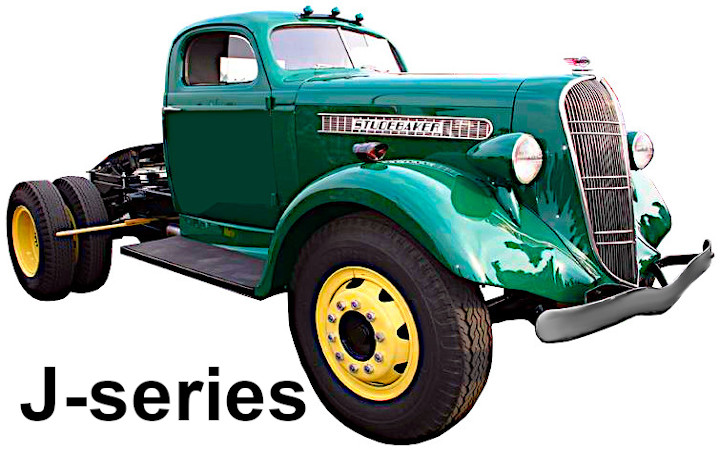 In
January of 1937 production of the J-Series trucks and buses starts. The standard trucks get a new cab loosely based on the 1937 car line. This cab is an all metal unit. The Cab-Forward trucks would continue
to use the 1936 cab, wood frame with steel sheathing. Both series
get a new grille, now with three sets of two horizontal cross bars. The J-5 Coupe Express discussed below did not use this grille, but
rather used the Dictator car grille. The “Coupe Cab” however was
shared with the Coupe Express and the Standard-series trucks, thus
both have wind wings which no other American made truck would have
until after WW II.
The big
news for 1937 was actually the release of the Coupe Express ½-ton
pickup which is based on the 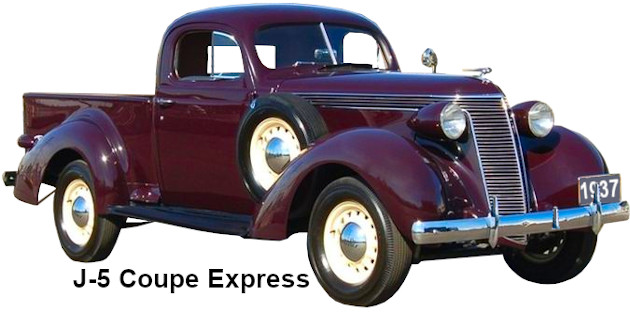 1937 Dictator passenger car. A limited
market for a light-duty pickup and a price 15 percent above the
competition did limit the success of an otherwise extraordinary
vehicle, which is in great demand today. Nevertheless 3,500 were
built in South Bend with another 375 being assembled in Studebaker's
new Vernon, California plant between January and July of 1937. Information about the J-5 Coupe Express will be found in the car line
as Studebaker considered the Coupe Express to just be another car
model. A few of the Coupe Express trucks were actually manufactured
as woody station wagons, the number is unknown and we expect none
have survived. Also in
1937 Studebaker would change from Waukesha engines to Hercules
engines for it's larger trucks and offer a diesel engine option for
the first time.
|
Model |
Production |
Model |
Production |
|
J15 |
4,827 |
J15M |
755 |
|
J15B |
143 |
J15MB |
2 |
|
J20 |
945 |
J20M |
316 |
|
J20B |
1 |
J20MB |
60 |
|
J20D |
37 |
J25M |
65 |
|
J25 |
137 |
J25MB |
25 |
|
J30 |
319 |
J30M |
60 |
|
Total |
6,409 |
Total |
1,283 |
|
Year |
Model |
Model Description |
Type |
Price |
|
1937 |
J-5 |
Coupe Express 116wb |
Truck |
$595.00 |
|
1937 |
J-15 |
1 ½-Ton Standard
Truck 138wb |
Truck |
? |
|
1937 |
J-15B |
1 ½-Ton Standard
Bus 187wb |
Bus |
? |
|
1937 |
J-15M |
1
½-Ton Cab-Forward Truck 101/138/162wb |
Truck |
? |
|
1937 |
J-20 |
2-Ton Standard
Truck 138/162/180wb |
Truck |
? |
|
1937 |
J-20B |
2-ton
Standard Bus 187wb |
Bus |
? |
|
1937 |
J-20D |
2-Ton
Diesel Standard Truck 138/162/180wb |
Truck |
? |
|
1937 |
J-20M |
2-Ton
Cab-Forward Truck 101/138/162wb |
Truck |
? |
|
1937 |
J-20MB |
2-Ton Cab-Forward
Bus 187wb |
Bus |
? |
|
1937 |
J-25 |
2 ½-Ton Standard
Truck 138/162/180wb |
Truck |
? |
|
1937 |
J-25M |
1
½-Ton Cab-Forward Truck 101/138/162wb |
Truck |
? |
|
1937 |
J-25MB |
2 ½-Ton
Cab-Forward Bus 187wb |
Bus |
? |
|
1937 |
J-30 |
3-Ton Standard
Truck 142/166/184wb |
Truck |
? |
|
1937 |
J-30M |
3-Ton
Cab-Forward Truck 101/142/166wb |
Truck |
? |
Source:
Most of the information in the
above section comes from “Studebaker the Complete Story” by
William A. Cannon and Fred K. Fox, Skip Lackie “Studebaker Truck
History.”
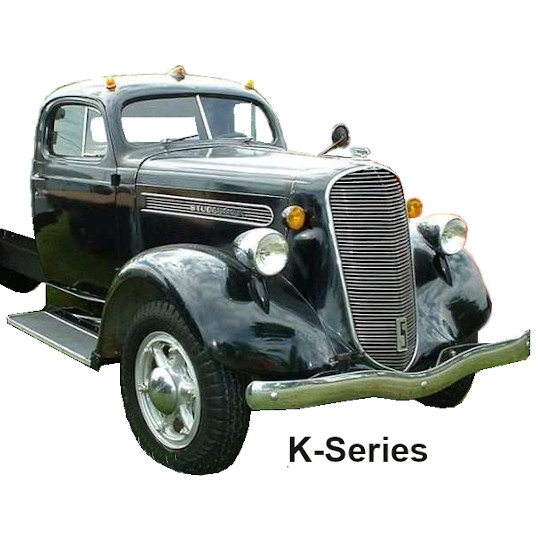 The 1938
to 1940 K-Series trucks began production in November 1937. K-Series
production would overlap the J-Series by a few weeks and last through
1942. With the war looming, a few would be built between
January-August of 1941 (338), (159) more in December of 1941 and
another (100) in February of 1942. The K-Series would sport a new
grille which now will have a series of simple horizontal bars. These
trucks would also have a large “S” badge on the lower grille.
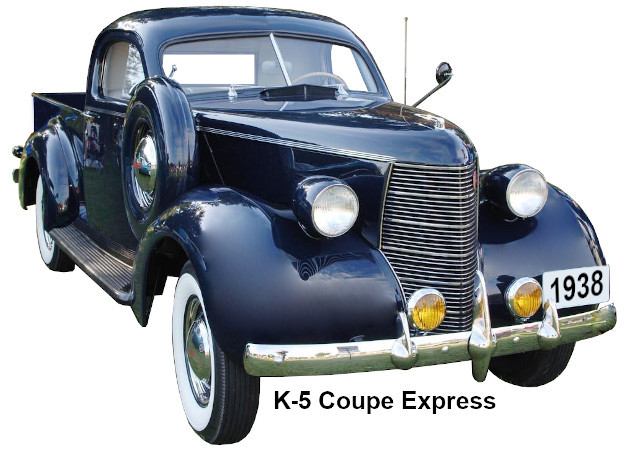 In
October of 1937 the K5 Coupe Express would began production a month
before the larger trucks. It's production would coincide with the
1937 car model year and end in July of 1938. 1,000 Coupe Express
pickups were built. The K5 Coupe Express would be based on the 1938
7A Studebaker Six/Commander. Again a few of the K5 Coupe Express
trucks were 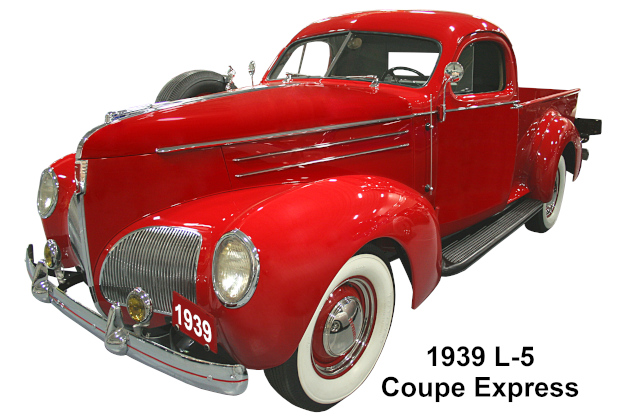 manufactured as woody station wagons. In 1939 the L5
Coupe Express is released based on the 9A Commander, the price is
reduced and 1,200 units would be built. This would be the end of the
Coupe Express line. In 1939 through 1941 Studebaker would promote
the sale of a Champion Coupe with a pickup box, in place inside the
trunk, with the rear deck lid removed, they called them the “Coupe
Delivery.” This has lead to some misconceptions that the Coupe
Express units were made through 1941, which they were not.
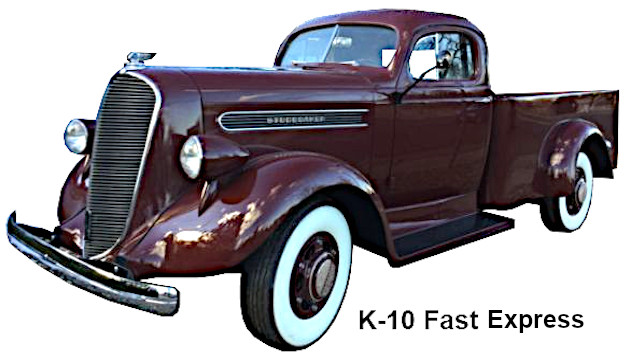 In 1938
Studebaker would also release the “Fast-Transport”, a new 1-ton
pickup. It came as a wide, steel floored, flat sided, “Express”
body. Later it would be available in Chassis & Cab, Chassis and
Cowl, Custom Panel or Stake Body. For 1939/1940 Studebaker would
add a narrow box version which had none of the fender well inside
the box. It was dubbed the “Standard-Express” and the wide
version would now be called the “Custom-Express”. Interesting
enough, the the wide version would become very popular in the 1960's
with the introduction of the “Fleetside” pickup box design (the
entire fender well inside the box.) Later yet, in the 1970's, they
would reintroduce the older style pickup boxes where the entire
fender was outside the box and call them “Flareside”. So, it
would appear the “Fast-Transport” of 1938 to 1940 was way ahead
of it's time.
|
Model |
Production |
Model |
Production |
|
K10 |
1,003 |
|
|
|
K15 |
4,482 |
K15M |
863 |
|
K15B |
217 |
K15MB |
109 |
|
K20 |
1,104 |
K20M |
372 |
|
K20B |
6 |
K20MB |
68 |
|
K20D |
29 |
K20MR |
964 |
|
K25 |
2,290 |
K25M |
87 |
|
K25B |
5 |
K25MB |
30 |
|
|
|
K25MR |
7 |
|
K30 |
116 |
K30M |
69 |
|
Total |
9,252 |
Total |
2,569 |
|
Year |
Model |
Model Description |
Type |
Price |
|
1938 |
K-5 |
Coupe Express
116.5wb |
Truck |
$735.00 |
|
1939 |
L-5 |
Coupe Express
116.5wb |
Truck |
$695.00 |
|
1938 |
K-10 |
1-Ton Fast
Transport Express 130wb |
Truck |
$960.00 |
|
1939/1940 |
K-10 |
1-Ton
Fast Transport Custom Express 130wb |
Truck |
$870.00 |
|
1939/1940 |
K-10 |
1-Ton
Fast Transport Standard Express 130wb |
Truck |
$832.00 |
|
1938/1940 |
K-15 |
1 ½-Ton Standard
Truck 138/162wb |
Truck |
? |
|
1938/1940 |
K-15B |
1 ½-Ton Standard
Bus 187wb |
Bus |
? |
|
1938/1940 |
K-15M |
1
½-Ton Cab-Forward Truck 101/138/162wb |
Truck |
? |
|
1938/1940 |
K-20 |
2-Ton Standard
Truck 138/162/180wb |
Truck |
? |
|
1938/1940 |
K-20B |
2-Ton Standard Bus
187wb |
Bus |
? |
|
1938/1940 |
K-20D |
2-Ton
Diesel Standard Truck 138/162/180wb |
Truck |
? |
|
1938/1940 |
K-20M |
2-Ton
Cab-Forward Truck 101/138/162wb |
Truck |
? |
|
1938/1940 |
K-20MB |
2-Ton Cab-Forward
Bus 187wb |
Bus |
? |
|
1938/1940 |
K-25 |
2 ½-Ton Standard
Truck 138/162/180wb |
Truck |
? |
|
1938/1940 |
K-25M |
1
½-Ton Cab-Forward Truck 101/138/162wb |
Truck |
? |
|
1938/1940 |
J-25MB |
2 ½-Ton
Cab-Forward Bus 187wb |
Bus |
? |
|
1938/1940 |
K-30 |
3-Ton Standard
Truck 142/166/184wb |
Truck |
? |
|
1938/1940 |
K-30M |
3-Ton
Cab-Forward Truck 101/142/166wb |
Truck |
? |
Source: Most of the information in the
above section comes from “Studebaker the Complete Story” by
William A. Cannon and Fred K. Fox, Skip Lackie “Studebaker Truck
History.”
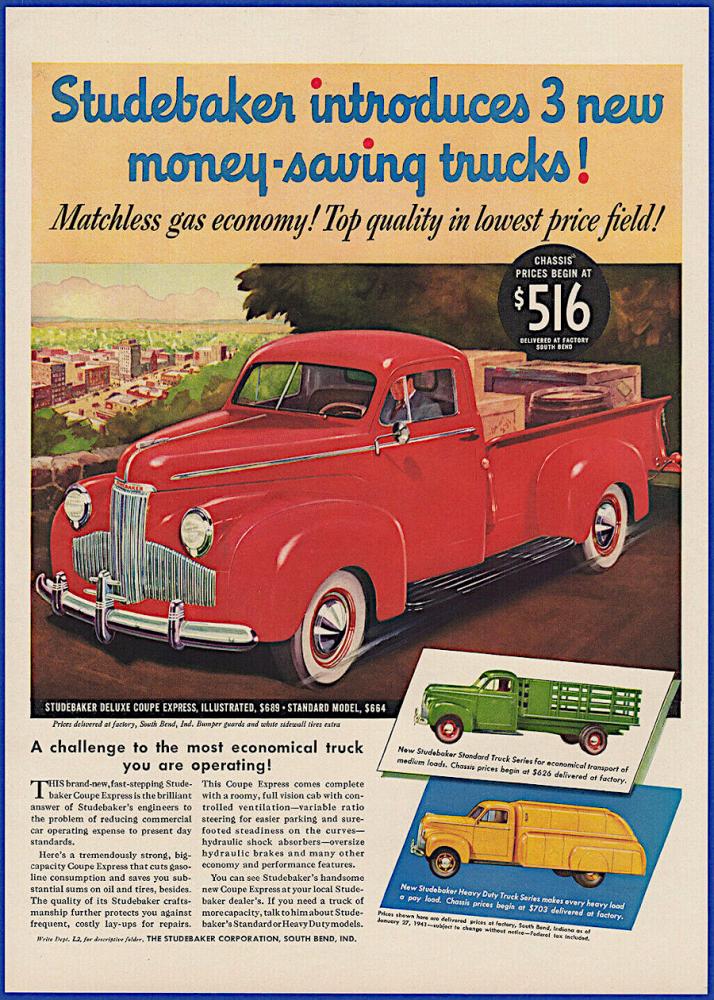 In
1941 Studebaker has made a decision to concentrate it's commercial
offering to pickup's and light-duty trucks. The M-Series is release
in ½ ton (M5), 1-ton (M15), 1 ½-ton (M16). Experts think the M10
number may have been reserved for a ¾-ton model which was never
released. The M5 and M15 used the 170-ci 80-hp engine, while the M16
gets the 226-ci Commander Six. The trucks would come in either
standard or DeLuxe trim. Standard trucks has painted grilles and
black fenders. Deluxe models had stainless steel grille bars, bright
metal side trim moldings, body colored fenders and a hood ornament.
Shown in the ad at the left (upper image) is the 1941 M5 DeLuxe, note that while it is still called a Coupe Express, it has nothing in common with the earlier car based Coupe Express pickups.
The DeLuxe packages were not available in 1942, this may have been
because of war material shortages or simply because the DeLuxe
packages did not sell well. The M-series has quite a few parts that
are borrowed from the 1941 Champion car line and in a unique design
have several parts like fenders and running boards which are
interchangeable from side to side or from front to back. Production
of the M5 Starts in November of 1940 while the M15 & M16 would
not start until December of 1940. From Skip Lackie's Truck History,
there were 1,085 M-series truck built in 1940, 9,215 in 1941 and 1,515
in 1942. There was no break-down of these numbers by model. From
Richard Quinn's May/June 1999 article in the Antique Studebaker
Review, there were 4,685 M-5's built in 1941 model year and another
174 built in the shortened 1942 model year.
|
Year |
Model |
Model Description |
Type |
Price |
|
1941 |
M5 |
½-ton Coupe
Express Standard 113wb |
Pickup |
$664.001 |
|
1941 |
M5 |
½-ton Coupe
Express DeLuxe 113wb |
Pickup |
$689.001 |
|
1941 |
M15 |
1-ton Standard
Express 120wb |
Pickup |
$815.001 |
|
1941 |
M15 |
1-ton Standard
Truck 128/152wb |
Truck |
? |
|
1941 |
M16 |
1
½-ton Heavy Duty Truck 128/152/195wb |
Truck |
? |
|
1942 |
M5 |
½-ton Coupe
Express Standard 113wb |
Pickup |
$695.001 |
|
1942 |
M15 |
1-ton
Standard Express 120wb |
Pickup |
$846.001 |
|
1942 |
M15 |
1-ton Standard
Truck 128/152wb |
Truck |
? |
|
1942 |
M16 |
1
½-ton Heavy Duty Truck 128/152/195wb |
Truck |
? |
|
1Turning
Wheels – October 2005 Page 9 & 10 Fred K. Fox feature
article. |
| Model |
Year |
Type |
WB |
Serial # |
Engine # |
Engine |
| 20 |
1912 |
Flanders Delivery |
100 |
? |
? |
Flanders |
| 3 |
1914 |
Delivery |
108 |
? |
? |
Studebaker Four |
| 5 |
1915 |
Delivery |
108 |
? |
? |
Studebaker Four |
| 7 |
1916/1917 |
Delivery |
112 |
? |
? |
Studebaker Four |
| Ton Truck |
125 |
? |
? |
| Jitney Bus |
125 |
? |
? |
| N |
1926/1927 |
12-15 Passenger Bus |
158 |
? |
? |
Big Six |
| A |
1926/1927 |
18-20 Passenger Bus |
184 |
? |
? |
Big Six |
| D |
1926/1927 |
12-15 Passenger Bus |
184 |
? |
? |
Big Six |
| EY |
1927 |
Arlington Funeral Car |
146 |
3,750,000 to 3,370,300 |
? |
Dictator Six |
| Bellevue Ambulance |
| GD |
1928 |
Arlington Funeral Car |
146 |
3,750,351 to 3,371,524 |
? |
Dictator Six |
| Bellevue Ambulance |
| 1-Ton Commercial |
140 |
| 51B |
1928 |
Erskine Panel Delivery |
109 |
5,038,005 to 5,047,401 |
1f-1 up |
Continental 9F |
| GK |
1929 |
Arlington Funeral Car |
146 |
3,751,550 to 3,753,009 |
GK-1 up |
Commander Six |
| Bellevue Ambulance |
| 1-Ton Commercial |
| 52B |
1929 |
Erskine Panel Delivery |
109 |
5,047,402 up |
? |
Continental 9F |
| Erskine Screen Delivery |
| 75 |
1928 |
Junior Bus |
158 |
? |
? |
Big Six |
| Heavy Duty Bus |
184 |
| 76 |
1928 |
Chassis |
? |
? |
? |
Big Six |
| FJ |
1929/1930 |
Westminster Funeral Car |
146 |
8,900,001 to 8,900,300 |
FJ-1 up |
Commander Eight |
| Samantan Ambulance |
| FE |
1929/1930 |
Funeral Car & Ambulance |
135 |
6,013,001 to 6,022,000 |
? |
President Eight |
| FL |
1929/1930 |
Funeral Car & Ambulance |
156 |
3,300,001 to 3,300,065 |
FL-1 up |
President Eight |
| GN |
1929/1930 |
Funeral Car & Ambulance |
146 |
3,760,001 to 3,761,350 |
GN-1 up |
Dictator Six |
| GN-20 |
¼ Ton Commercial |
115 |
| GN-30 |
1-Ton Commercial |
130 |
| GN-40 |
2-Ton Commercial |
146 |
| 77 |
1929/1930 |
Junior Bus |
158 |
3,251,351 up |
? |
President Eight |
| 88 |
Special Bus |
184 |
| 99 |
Heavy Duty Bus |
| 111 |
Heavy Duty Bus |
184 |
3,251,756 up |
? |
| 220 |
| S-100 |
1931 |
Funeral Car & Ambulance |
154 |
8,900,301 to 8,900,400 |
|
Commander Eight |
| S-101 |
1932 |
Funeral Car & Ambulance |
152 |
8,900,401 to 8,900,600 |
|
| S-102 |
1933 |
Funeral Car & Ambulance |
152 |
8,900,601 up |
|
| S |
1930/1931 |
1 ½ Ton Truck |
130 |
3,400,001 up |
1T-101 up |
Studebaker Six |
| 160 |
3,425,001 up |
| 136 |
3,500,001 up |
2T-101 up |
| 148 |
3,450,001 up |
| 160 |
3,475,001 up |
| S1 |
1931 |
½ Ton Delivery |
114 |
3,375,001 up |
T-101 up |
Studebaker Six |
| S2 |
1932/1934 |
1/ Ton Truck |
130 |
3,402,001 up |
1T-3,301 up |
Studebaker Six |
| 145 |
3,350,001 up |
| 165 |
3,426,101 up |
| S-111 |
1932 |
Delivery |
? |
5,900,01 to 95,900,050 |
? |
Studebaker Six |
| S-116 |
9,900,001 to,900,025 |
? |
| S-4 |
1932/1934 |
1 ¾ Ton Truck |
130 |
3,415,001 up |
1T-4,601 up |
Studebaker Six |
| 141 |
3.365,001 up |
| 165 |
3,440,001 up |
| S-6 |
1932/1934 |
2 Ton Truck |
141 |
3,500,301 up |
2T-3,501 up |
Studebaker Six |
| 153 |
3,451,001 up |
| 165 |
3,477,001 up |
| S-8 |
1932/1934 |
3 Ton Truck |
141 |
3,525,001 up |
3T-101 up |
Studebaker Six |
| 153 |
5,550,001 up |
| 165 |
3.575,001 up |
| 183 |
3,600,001 up |
| T-2 |
1934 |
1 ½ Ton Standard Truck |
130 |
T2-101 up |
1T-6,301 up |
Studebaker Six |
| 141 |
| 165 |
| T-4 |
1934 |
1 ¾ Ton Standard Truck |
130 |
T4-101 up |
1T-6,301 up |
Studebaker Six |
| 141 |
| 165 |
| T-6 |
1934 |
2 Ton Standard Truck |
141 |
T6-101 up |
2T-5,901 up |
Studebaker Six |
| 153 |
| 165 |
| T-8 |
1934 |
3 Ton Standard Truck |
141 |
T8-101 up |
3T-1,301 up |
Studebaker Six |
| 165 |
| 183 |
| W-8 |
1934 |
Big Chief 2 Truck |
141 |
W8-101 up |
6-110-352,296 up |
Waukesha 6-110 |
| 165 |
| 183 |
| T-2 |
1935 |
1 ½-2 Ton Standard Truck |
130 |
1T2-1,801 up |
1T-8,551 up |
Studebaker Six |
| 141 |
| 165 |
| T-6 |
1935 |
2-3 Ton Standard Truck |
141 |
1T6-1,001 up |
2T-7,151 up |
Studebaker Six |
| 153 |
| 165 |
| 183 |
| W-7 |
1935 |
Mogal 3 Truck |
141 |
W8-101 up |
6BK-366,676 up |
Waukesha BK |
| 165 |
| 183 |
| W-8 |
1935 |
Big Chief 3 Truck |
141 |
1W8-501 up |
6-110-358308 up |
Waukesha 610 |
| 165 |
| 183 |
| 2T-2 |
1936 |
Standard Truck Ace |
125 |
2T2-4,401 up |
1T-12,001 up |
Studebaker Six |
| 133 |
| 157 |
| 2T28 |
1936 |
Bus |
157 |
2T28-101 up |
1T-12,001 up |
Studebaker Six |
| 2M2 |
1936 |
Cab Forward Truck |
101 |
2M2-101 up |
1T-12,001 up |
Studebaker Six |
| 125 |
| 2M6 |
1936 |
Metro Boss |
125 |
2M6-101 up |
6BM-379,456 up |
Waukesha BM |
| 157 |
| 2M6B |
1936 |
Bus |
167 |
2M6B-101 up |
6BM-379,456 up |
Waukesha BM |
| 2W6 |
1936 |
Boss Truck Standard |
133 |
2W6-101 up |
6BM-379,456 up |
Waukesha BM |
| 157 |
| 175 |
| 2W7 |
1936 |
Standard Truck |
141 |
2W7-401 up |
6BK-367,291 up |
Waukesha BK |
| 165 |
| 183 |
| 2W8 |
1936 |
Standard Truck |
141 |
2W8-801 up |
6-110-269,837 up |
Waukesha 6-110 |
| 165 |
| 183 |
| J-5 |
1937 |
Coupe Express |
116 |
J5-001 up |
T-701 up |
Studebaker Six |
| J15 |
1937 |
1 ½ Ton Standard Truck |
138 |
J15-001 up |
1T-16,301 up |
Studebaker Six |
| J15B |
1937 |
1 ½ Ton Bus |
187 |
J15B-001 up |
1T-16,301 up |
Studebaker Six |
| J15M |
1937 |
1 ½ Ton Cab Forward |
101 |
J15M-001 up |
1T-16,301 up |
Studebaker Six |
| 138 |
| 162 |
| J20 |
1937 |
2-ton Standard Truck |
138 |
J20-001 up |
JXB 567,931 up |
Hercules JXB |
| 162 |
| 180 |
| J20M |
1937 |
2-ton Cab Forward Truck |
101 |
J20M-001 up |
JXB 567,931 up |
Hercules JXB |
| 138 |
| 162 |
| J20MB |
1937 |
2-ton Cab Forward Bus |
187 |
J20MB-001 up |
JXB 567,931 up |
Hercules JXB |
| J25 |
1937 |
2 1/2-ton Standard Truck |
138 |
J25-001 up |
JXD 567,243 up |
Hercules JXD |
| 162 |
| 180 |
| J25M |
1937 |
2 1/2-ton Cab Forward |
101 |
J25M-001 up |
JXD 567,243 up |
Hercules JXD |
| 138 |
| 162 |
| J25MB |
1937 |
2 1/2-ton Cab Forward Bus |
187 |
J25MB-001 up |
JXD 567,243 up |
Hercules JXD |
| J30 |
1937 |
3-ton Standard Truck |
142 |
J30-001 up |
WXC3-168,003 up |
Hercules WXC3 |
| 166 |
| 184 |
| J30M |
1937 |
3-ton Cab Forward Truck |
101 |
J30M-001 up |
WXC3-168,003 up |
Hercules WXC3 |
| 138 |
| 162 |
| K-5 |
1938 |
Coupe Express |
116 |
K5-001 up |
T-4,301 up |
Studebaker Six |
| H-7,801 up |
| K10 |
1938/1940 |
1-ton Fast Transport |
130 |
K-10,001 up |
OT-101 up |
Studebaker Six |
| K-15 |
1938/1940 |
1 ½ Ton Standard Truck |
138 |
K15-001 up |
1T-21,931 up |
Studebaker Six |
| 162 |
| K15B |
1938/1940 |
Standard Bus |
187 |
K15B-001 up |
1T-21,935 up |
Studebaker Six |
| K15M |
1938/1940 |
Cab Forward Truck |
101 |
K15M-001 up |
1T-21,935 up |
Studebaker Six |
| 138 |
| 162 |
| K20 |
1938/1940 |
2-ton Standard Truck |
138 |
K20-001 up |
JXB 592,276 up |
Hercules JXB |
| 162 |
| 180 |
| K20M |
1938/1940 |
2-ton Cab Forward Truck |
101 |
K20M-001 up |
JXB 592,276 up |
Hercules JXB |
| 138 |
| 162 |
| K20MB |
1938/1940 |
2-ton Cab Forward Bus |
187 |
K20MB-001 up |
JXB 592,276 up |
Hercules JXB |
| K25 |
1938/1940 |
2 1/2-ton Standard Truck |
138 |
K25-001 up |
JXD 597,644 up |
Hercules JXD |
| 162 |
| 180 |
| K25M |
1938/1940 |
2 1/2-ton Cab Forward |
101 |
K25M-001 up |
JXD 597,644 up |
Hercules JXD |
| 138 |
| 162 |
| K30 |
1938/1940 |
3-ton Standard Truck |
142 |
K30-001 up |
WXC3-469,604 up |
Hercules WXC3 |
| 166 |
| 184 |
| K30M |
1938/1940 |
3-ton Cab Forward Truck |
101 |
K30M-001 up |
WXC3-469,604 up |
Hercules WXC3 |
| 138 |
| 166 |
| L5 |
1939 |
Coupe Express |
116 |
L5-001 up |
H-42,501 up |
Studebaker Six |
| M5 |
1941/1946 |
Coupe Express |
113 |
M5-001 up |
1M-001 up |
Champion Six |
| M15 |
1941/1942 |
Standard Truck |
120 |
M15-001 up |
2M-001 up |
Champion Six |
| 128 |
| 152 |
| M16 |
1941/1942 |
Heavy Duty Truck |
128 |
M16-001 up |
3M-001 up |
Champion Six |
| 152 |
| 195 |
| Notes: Where ever you find a “?” it represents that the information is unknown. Data for model S-2 include S-21 & S-31. Data for model S-6 include S-41, S-51 & S-61. Data for model S-8 include S-120, S-130, S-140 & S-150. | Top Of Page |